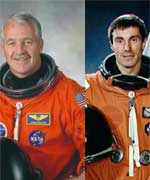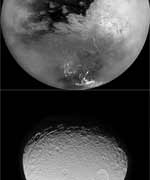Monday, November 22 – How about taking time to study a bit of astronomy this morning before a busy work week begins? Before dawn, ultra-bright Venus commands the ecliptic plane. Just above it, blue star Spica and mighty Jupiter capture attention and dim, red Mars is below Venus. This is a wonderful sight for just the unaided eye, but why not try a challenge this morning? All it will require is binoculars and clear sky! For viewers in both hemispheres, (40 degrees and below) the time is perfect to locate Comet C/2003 K4 LINEAR as it slides just slightly south of visible star Beta Hydra. At an estimated magnitude of 5, it will be a beauty for the Southern Hemisphere and a challenge for the North!
Tonight’s lunar feature can be spotted in binoculars, but needs a telescope to be studied. The Riphaeus Mountains will appear to the southwest of Copernicus. Highlighted by the bright ring of Euler, the Riphaeus Mountains under high power show a variety of isolated hills and sharp peaks which may have been the original crater walls of Mare Cognitum before having been filled with lava flow. Northeast of this range is an area with a smooth floor on the border of Oceanus Procellarum. It is here that Surveyor 3 landed on April 19, 1967. After having bounced three times, the lunar probe came to rest on a smooth slope in a sub-telescopic crater. As its on-board television monitors watched, Surveyor 3 deployed the “first of its kind” miniature power shovel and dug to a depth of 18 inches. The revelation of sub-soil material and clean-cut lines allowed scientists to come to the conclusion that the loose lunar soil was capable of compaction. Watching as Surveyor 3 pounded its shovel against the surface, the tiny “dents” it produced answered the crucial question – the surface of a mare would support the landing of a spacecraft and subsequent exploration by astronauts.
In the mood to stay up late tonight? Then wait until well past midnight until Orion has risen well in the sky and let’s try for another comet despite the Moon. Comet C/2004 Q2 (Machholz) is visible to larger binoculars, but better achieved in telescopes for northern viewers 40 degrees and below. At around magnitude 8, it will appear on the Columba/Caelum border. Viewers in both hemispheres should enjoy this one!
Tuesday, November 23 – The first photograph of a meteor shower was taken on this day in 1885 in Prague, Czechoslovakia but no picture can rival the beauty of the predawn skies as Venus once again dominates the scene. While lovely Spica and Jupiter try to steal the show, try to ignore them as it’s time to start observing Mars (right below Venus) and watch in the coming days as they appear closer and closer together.
Weather satellite Tiros II was launched on this day in 1960. Carried to orbit by a three-stage Delta rocket, the “Television Infrared Observation Satellite” was about the size of a barrel, testing experimental television techniques and infrared equipment. Operating for 376 days, Tiros II sent back thousands of pictures of Earth’s cloud cover and was successful in its experiments to control orientation of satellite spin and infrared sensors. Oddly enough, a similar mission – Meteosat1- also became the first satellite put into orbit in 1977 on this day by the European Space Agency. Where is all this leading? Why not try observing satellites on your own! Thanks to a wonderful tool from NASA you can be alerted by email whenever a bright satellite makes a pass for your specific area. It’s fun!
Tonight’s lunar feature will be bright, medium-sized class one crater, Artistarchus. On the terminator tonight north of Keplar, this dazzling feature can sometimes be seen by the naked eye and with no problem in binoculars. For telescopic viewers, Aristarchus will offer up a splendid challenge as you are encouraged to look for a thin, bright thread that curls away from it. Named Schroter’s Valley, it is a sinous rille and the largest of its kind. It may have once been a lava drainage channel, for it bears similarities with our own terrestrial volcanic features.
Wednesday, November 24 –
Heads up! There will an occulation of a bright star tonight by an asteroid. Visible from the NE to SW United States, Asteroid 860 Ursina will occult HIP 11395 (magnitude 7). For more details, click here for an IOTA locater chart and prediction times.
Comet C/2001 T4 (NEAT) will make its closest approach to Earth at a distance of 8.190 AU. Dry fact or an observable reality? Comet T4 is indeed very visible to the northern hemisphere, but it is not for the faint of heart. Right now it is holding around a magnitude 11 and is cutting its way across the Draco/Bootes border, making it a prime target for early morning viewers when the Moon is as low as it can possibly be. Requiring at least 12.5 inches of aperture, T4 will closely resemble a small, out-of-focus globular cluster since the Moon will toast any indication of coma. Are you up to that kind of challenge? I dare ya…
Tonight’s highlighted lunar feature can be seen in binoculars but best viewed with a telescope. Located in the southwest quadrant and on the terminator just south of Shickard, crater Wargentin is most unique. Once upon a time, it was a very normal crater and had been that way for hundreds of millions of years – then it happened. Either a fissure opened in its interior, or the meteoric impact that formed it caused molten lava to begin to rise. Oddly enough, Wargentin’s walls were without large enough breaks to allow the lava to escape and it continued to fill the crater to the rim. Often referred to as “the Cheese”, enjoy Wargentin tonight for its unusual appearance!
Thursday, November 25 – Ready to aim for a bullseye? Then tonight as darkness completely falls, go have a look at the Moon. To the right of it will be the M45, or the Pleiades star cluster. Just below it you will note bright, reddish star, Aldeberan. Set your eyes, scopes or binoculars there and let’s look into the “eye” of the Bull.
Known early on as “Al Dabaran”, or “the Follower”, Alpha Tauri it took its name for the fact that it appears to follow the Pleiades across the sky. In Latin it was “Stella Dominatrix”, yet the old English knew it as “Oculus Tauri”, or very literally the “eye of Taurus”. No matter which ancient astronomy lore we explore, there is reference to Aldeberan. As the 13th brightest star in the sky, it almost appears from Earth to be a member of the V-shaped Hyades star cluster, but its association is merely coincidental since it is about twice as close to us as the cluster. In reality, Aldeberan is really on the small end as far as K5 stars go and like many other orange giants, could possibly be a variable. Aldeberan is also known to have five close companions, but they are faint and highly difficult to observe with backyard equipment. At a distance of approximately 68 light years away, Alpha is only about 40 times larger than our own Sun and approximately 125 times brighter. To get a grasp on that size, think of it as being about the same size as the Earth’s orbit! Because of its position along the ecliptic, Aldeberan is one of the very few stars of first magnitude that can be occulted by the Moon.
And speaking of Moon, let’s explore tonight’s lunar feature – Galileo. It is a challenge for binoculars to spot this feature, but telescopes of any size capable of higher power will find it easily on the terminator to the west, northwest section of the Moon. Set in the smooth sands of Oceanus Procellarum, Galileo is a very tiny, eye-shaped crater and has a soft rille that accompanies it. It was named for the very man who first viewed and contemplated the Moon through a telescope. No matter what lunar resource you chose to follow, all agree that giving such an insignificant crater a great name like Galileo is unthinkable! For those of you familiar with some of the outstanding lunar features, read this account of Galileo’s life and just look at how many spectacular craters were named for people he supported! We cannot change the names of lunar cartography, but we can remember Galileo’s many accomplishments each time we view this crater.
Friday, November 26 – Today is the fifth anniversary of the discovery of SAU 005 & 008 labeled “Mars Meteorites”. These meteorites are known to be of Mars origin because of gases preserved in the glassy material of their interior. They were hurled into space some 600,000 years ago when a probable asteroid impact on Mars tossed them high enough to escape the planet’s gravity and were captured by our gravity thousands of years later. These are just 2 of the 32 meteorites found on Earth positively classed from their chemical compositions to be of Martian origin.
Comet 32P Comas Sola will make its closest approach to the Earth at a distance of 1.237 AU, but is it visible? The answer is yes. At around magnitude 13, Comas Sola is within the range of large aperture telescopes, but viewing will be difficult tonight thanks to the full Moon. Now cruising the border of Cetus and Aries, 32P can be found very near Mu Cetus. If you cannot spot it tonight, try in just a few days when the later rise of the Moon will provide darker skies.
Since it will be bright tonight, why don’t we try doing something a little different with an astronomical twist? Earlier in the week we discussed watching satellites, so how about if we learn how and when to locate the International Space Station! It’s easy to discover visible passes of the ISS using tools like this link provides, and even more fun to watch them. There may be a pass that will occur tonight in your area, and you might have to wait a few days, but the tool is now in your hands to predict the sightings. If you are new to the astronomy game, it may take a few times before the numbers that determine the height of the pass make sense from where you view, but don’t be discouraged if you don’t spot it right away. A rule of thumb is an altitude value of 10 means it will be very low on the horizon, while one of 90 means it will pass directly overhead. It’s very exciting to follow with binoculars because you can make out a certain amount of detail and those talented enough to “track” with a telescope will see even more. Even if you just watch with your eyes, it’s still a wonderful event that folks of all ages enjoy. Happy Hunting!
Tonight’s full Moon is also known as the “Frost Moon” and there is little doubt about how its name came to be! For those of you interested in viewing lunar features tonight, libration will be favourable to study a collection of shallow, dark craters known as Mare Australe. Located on the southeastern limb, this large binocular and telescopic object is well-worth locating because it isn’t always visible to the degree it will be tonight.
Saturday, November 27 – Tonight Uranus is at opposition. No, this doesn’t mean the planet is causing an altercation in the heavens or joining a political party. It just means that Uranus has now reached the point in its orbit where its celestial longitude is precisely 180 degrees from that of the Sun. Here’s a tip: planets that have reached opposition are visible all night long!
Tonight, rather than adventure on the lunar surface, let’s turn our eyes to the far north and explore the constellation of Cassiopeia. Almost everyone is familiar with the legend of Cassiopeia and how the Queen came to be bound in her chair, destined for an eternity to turn over and over in the sky, but did you know that Cassiopeia holds a wealth of double stars and galactic clusters? Seasoned sky watchers have long been familiar with this constellation’s many delights, but let’s pretend that not everyone knows where they are all at and tonight let’s begin our exploration of this Cassiopeia with a two of its primary stars.
Looking much like a flattened “W” the southern-most bright star is Alpha. Also known as Schedar, this magnitude 2.2 spectral type K star, was once suspected of being a variable, but no changes have been detected in modern astronomy. Binoculars will reveal its orange/yellow coloring, but a telescope is needed to bring out its unique features. In 1781, Sir William Herschel discovered a 9th magnitude companion star and our modern optics easily separate the blue/white component’s distance of 63″. A second, even fainter companion at 38″ is mentioned in the list of double stars and even a third at 14th magnitude was spotted by S.W. Burnham in 1889. All three stars are optical companions only, but make 150 to 200 light year distant Schedar a delight to view!
Just north of Alpha is the next destination for tonight… Eta Cassiopeiae. Discovered by Sir William Herschel in August of 1779, Eta is quite possibly one of the most well-known of binary stars. The 3.5 magnitude primary star is a spectral type G, meaning it has a yellowish color much like our own Sun. It is about 10% larger than Sol and about 25% brighter. The 7.5 magnitude secondary (or B star) is very definitely a K-type, metal poor, and distinctively red. In comparison, it is half the mass of our Sun, crammed into about a quarter of its volume and around 25 times dimmer. In the eyepiece, the B star will angle off to the northwest, providing a wonderful and colorful look at one of the season’s finest!
Sunday, November 28 – Why not step outside this morning before dawn and have a look at Mars just below Venus on the horizon? This would be a fitting way to celebrate the 40th anniversary of the Mariner 4 launch. Mariner 4 gave us our first “up close and personal” looks of the planet’s surface as it beamed back 22 television pictures of Mars’ barren, dusty red surface. As we look at Mars this morning, think of all the changes that have occurred in its exploration in just 40 years!
Heads up for this evening! In a line from Greenland, through Canada, to the northwest United States, Asteroid 80 Sappho will occult HIP 19229 (7.9 magnitude). For the northeast to southwest United States, 64 Angelina will occult SAO093069(b) (magnitude 11.3) and then a bit later take out SAO093069(a) (magnitude 10) for the southeast/southwest United States. Be sure to click on the links for appropriate times and finder charts supplied by IOTA.
Thanks to just a slightly later rise of the Moon, let’s return again to Cassiopeia and start first by exploring the central most bright star, Gamma. At approximately 100 light years away, Gamma is a very unusual star. Once thought to be a variable, this particular star has been known to go through some very radical changes with its temperature, spectrum, magnitude, color and even diameter! Gamma is also a visual double star, but the 11 magnitude companion is highly difficult to perceive so close (2.3″) from the primary.
Four degrees southeast of Gamma is our marker for this starhop, Phi Cassiopeiae. By aiming binoculars or telescopes at this star, it is very easy to locate an interesting open cluster, NGC457, because they will be in the same field of view. This bright and splendid galactic cluster has received a variety of names over the years because of its uncanny resemblance to a figure. Some call it an “Angel”, others see it as the “Zuni Thunderbird”, I’ve heard it called the “Owl” and the “Dragonfly”, but perhaps my most favourite is the “E.T. Cluster”, As you view it, you can see why! Bright Phi and HD 7902 appear like “eyes” in the dark and the dozens of stars that make up the “body” appear like outstretched “arms” or “wings”. (For E.T. fans? Check out the red “heart” in the center.)
All this is very fanciful, but what is the NGC457, really? Both Phi and HD 7902 may not be true members of the cluster. If magnitude 5 Phi were actually part of this grouping, it would have to have a distance of approximately 9300 light years, making it the most luminous star in the sky, far outshining even Rigel! To get a rough of idea of what that means, if we were to view our own Sun from this far away, it would be no more than magnitude 17.5. The fainter members of the NGC457 comprise a relatively “young” star cluster that spans about 30 light years across. Most of the stars are only about 10 million years old, yet there is 8.6 magnitude red supergiant in the center.
No matter what you call it, the NGC457 is an entertaining bright cluster that you will find yourself returning to again and again. Enjoy!
Until next week? Keep looking up and enjoying the wonders of the night sky! Wishing you clear skies and light speed…
~Tammy Plotner




